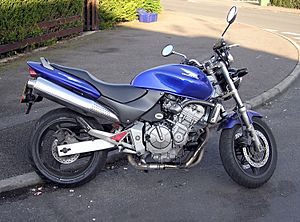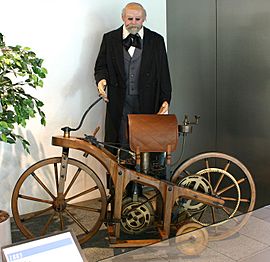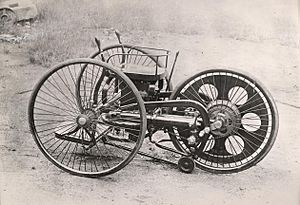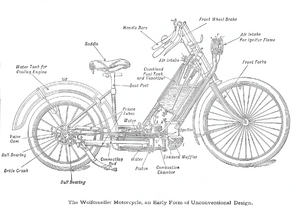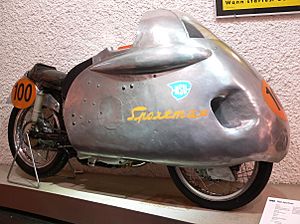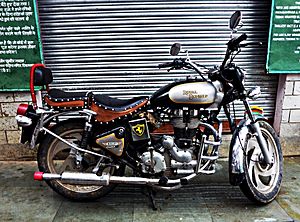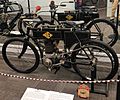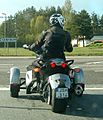Motorcycle facts for kids
A motorcycle or motorbike is a vehicle that helps people travel. Unlike a car, it only has two wheels, similar to a bicycle. But like a car, it has an engine. Usually, one person drives a motorcycle. Sometimes, a passenger can ride on the back. Some motorcycles even have a sidecar to carry another person.
The first successful motorcycle was made in 1901 by "Indian" motorcycles in Springfield, Massachusetts. Since then, many companies have built them. Big names include Honda, Suzuki, and Yamaha. A famous American motorcycle maker is Harley-Davidson.
Motorcycles are lighter than cars, so they can go fast very quickly. However, they are not as safe as cars. This is because they do not have a strong frame around the rider like a car does. Motorcycle riders often get badly hurt in accidents. To stay safer, riders can wear a helmet and special clothing with padding or armor. This gear can help reduce injuries in a crash. Motorcycles also do not protect riders from wind or rain. This makes them hard to ride in winter or bad weather.
In some countries, motorcycles are a cheap way to get around. Many people who cannot afford a car can buy a small motorcycle. In richer countries, large, powerful motorcycles are often used for fun or for sports.
Motorcycles that can be ridden on public roads are called "on-road bikes." You need a special driver's license to ride them legally. "Off-road bikes" are not allowed on public roads. Off-road bike sports often focus on speed and cool stunts. Many on-road bikes are much faster than off-road bikes. They are used in races like motorbike racing.
Contents
How Motorcycles Started
Early Ideas and Inventions
The very first motorcycle with an internal combustion engine (which uses gasoline) was the Daimler Reitwagen. Two German inventors, Gottlieb Daimler and Wilhelm Maybach, designed and built it in Germany in 1885. This vehicle was different from bicycles of that time. It had two small side wheels to help it stay upright when turning.
The inventors called their invention the Reitwagen, which means "riding car." They built it mainly to test their new engine.
Another early design was the Butler Petrol Cycle. Edward Butler in England thought of this three-wheeled vehicle in 1884. It was built in 1888. The Butler Petrol Cycle had a small, powerful engine for its time. It used new ideas like special valves and a fuel system. It even started with compressed air. The vehicle had no brakes; the driver stopped it by lifting the back wheel. This invention was not a success because Butler could not find enough money to produce it.
Some people only call vehicles with gasoline engines "motorcycles." But if we include two-wheeled vehicles powered by steam, then the first ones were built even earlier. The French Michaux-Perreaux steam velocipede and the American Roper steam velocipede were made around 1867-1868. Sylvester H. Roper showed his steam machine at fairs in the U.S.
First Motorcycle Companies
In 1894, Hildebrand & Wolfmüller became the first company to mass-produce motorcycles. They were also the first to call them "Motorrad" (motorcycle in German). Excelsior Motor Company in England started making motorcycles in 1896. The first production motorcycle in the U.S. was the Orient-Aster, built in 1898.
In the early days, many bicycle makers started adding engines to their bikes. As engines got stronger, more companies began making motorcycles. Many inventors who worked on early motorcycles later moved on to create cars.
Around 1900, the first big motorcycle companies were formed. In 1898, Triumph Motorcycles in England began making bikes. By 1903, they made over 500 bikes a year. Other British companies like Royal Enfield and Norton also started. In the U.S., Indian began in 1901, and Harley-Davidson started two years later. Before World War I, Indian was the largest motorcycle maker, producing over 20,000 bikes each year.
Motorcycles in World War I
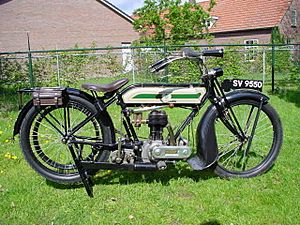
During World War I, motorcycle production greatly increased for the war effort. Motorbikes were used to send messages to soldiers on the front lines. They also helped with scouting and police work. By the end of the war, Harley-Davidson was making more than half of its motorcycles for the military. Triumph Motorcycles sold over 30,000 of its Triumph Type H model to the allied forces. This model had a 499 cc engine and was the first Triumph without pedals.
Many people consider the Triumph Model H, introduced in 1915, to be the first "modern motorcycle." It had a 550 cc engine with a three-speed gearbox. It was so popular and reliable that soldiers nicknamed it the "Trusty Triumph."
After the Wars
By 1920, Harley-Davidson was the biggest motorcycle maker. Their bikes were sold in 67 countries. Later, in the late 1920s or early 1930s, DKW in Germany became the largest manufacturer.
In the 1950s, motorcycle racing saw new designs that were more aerodynamic, meaning they cut through the air better. This was called "streamlining." Companies like NSU and Moto Guzzi made very advanced designs. NSU created the most modern designs, but after some accidents, they stopped racing.
Moto Guzzi also made fast racing bikes. By 1957, most Grand Prix races were won by these streamlined machines. However, in 1958, racing officials banned full body fairings (covers) because of safety worries.
From the 1960s to the 1990s, small two-stroke motorcycles were very popular around the world. This was partly thanks to engine improvements made by Walter Kaaden in East Germany.
Motorcycles Today
In the 21st century, the motorcycle world is mostly led by companies from India and Japan. Besides large motorcycles, there is a big market for smaller bikes (under 300 cc). These are mostly found in Asian and African countries and are made in China and India. A great example is the 1958 Honda Super Cub. It became the best-selling vehicle of all time, with 60 million units made by 2008.
Today, Indian companies are very important in this area. Hero MotoCorp is the world's largest maker of two-wheelers. Their Splendor model has sold over 8.5 million bikes. Other major Indian makers are Bajaj and TVS Motors.
Motocross Racing
Motocross is a type of motorcycle racing. It takes place on special off-road tracks. This sport grew from motorcycle competitions held in the United Kingdom.
Images for kids
-
A 1952 Lambretta 125 D scooter
See also
 In Spanish: Motocicleta para niños
In Spanish: Motocicleta para niños


